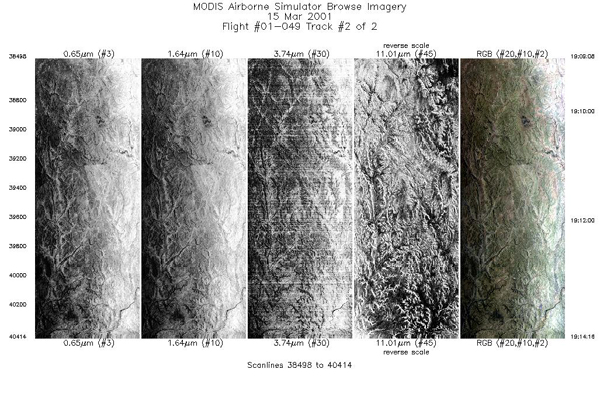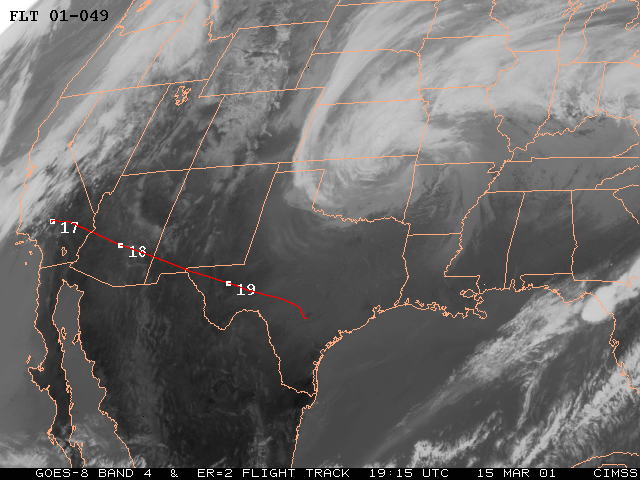TX 2001: Terra eXperiment 2001 (TX 2001)
The Terra eXperiment is being conducted from Kelly AFB San Antonio, Texas from March 14 to April 4, 2001 to collect data to assess thermal infrared (TIR) calibration accuracy of the MODerate resolution Imaging Spectroradiometer (MODIS) flying onboard NASA’s EOS Terra satellite. MODIS IR bands are used in many global science products, including sea surface and land surface temperature, cloud top properties (particle phase, height, emissivity, temperature), cloud mask, total column ozone and atmospheric moisture, and atmospheric temperature.
TX-2001 will employ a NASA high altitude (20 km) ER-2 aircraft to underfly the Terra spacecraft for direct comparisons between the ER-2 based data and the MODIS data. The ER-2 (Earth Resources) is a research version of the well known U-2 aircraft and flies above about 95% of the earth’s atmosphere, closely emulating satellite based measurements from outer space. The ER-2 will carry the MODIS Airborne Simulator (MAS) and the Scanning High-resolution Interferometer Sounder (SHIS) radiometric instruments to measure upwelling TIR radiance from the earth-atmosphere system in much the same way that MODIS measures the earth-atmosphere system. The MAS instrument provides high spatial resolution (50 m) data for simulating the MODIS 1 km TIR bands. SHIS provides high spectral resolution data and excellent radiometric accuracy to which the MODIS TIR calibration assessment is ultimately pinned. In the data analysis phase, the SHIS calibration accuracy is transferred to MAS and the MODIS 1 km footprint is mapped onto the MAS imagery for direct comparisons of MAS and MODIS spectral bands.
The ER-2 data collection will consist of about six flights over the Gulf of Mexico in clear sky conditions when the Terra satellite is passing overhead (about 10:30 LT). The Gulf of Mexico is an advantageous site for this work because of its thermal stability and broad uniformity (unlike land surfaces which heat and cool rapidly and tend to have much small scale thermal variability); this allows a small but important margin of error in co-registering the data from the ER-2 based instruments and MODIS on Terra. The ER-2 will fly at nadir and off-nadir MODIS positions to assess the MODIS scan mirror influence on the MODIS L1B accuracy. At least one flight will be planned to collect data at the same viewing geometry as when MODIS views its own onboard blackbody thermal reference. Under this condition, the scan mirror influence is effectively removed from the assessment, isolating the influence of the MODIS blackbody on the TIR calbration.
TX-2001 is the third in an ongoing series of ER-2 field experiments designed in part to assess MODIS L1B TIR calibration. The WISC-T2000 (March 2000) and SAFARI-2000 (Aug/Sep. 2000) experiment data sets have contributed to the MODIS TIR calibration assessment. TX-2001 will continue the assessment by providing insight on MODIS calibration trends over time as well as providing first time insight on the separate influence of the MODIS scan mirror and onboard blackbody reference on the TIR calibration.
Cooperative Institute for Meteorological Satellite Studies (CIMSS), University of Wisconsin-Madison
Investigators
- Christopher Moeller Cooperative Institute for Meteorological Satellite Studies (CIMSS)
Related Websites
Images
-

MODIS quicklooks, 0.5 km resolution, Texas, 15 March 2001
Cooperative Institute for Meteorological Satellite Studies (CIMSS), University of Wisconsin-Madison -

MODIS Airborne Simulator browse imagery, 14 March 2001
Cooperative Institute for Meteorological Satellite Studies (CIMSS), University of Wisconsin-Madison -

ER-2 flight track overlaid on GOES-8 image, 15 March 2001
Cooperative Institute for Meteorological Satellite Studies (CIMSS), University of Wisconsin-Madison
